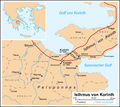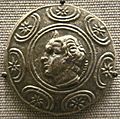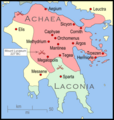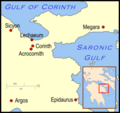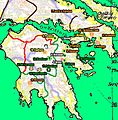Aratus of Sicyon facts for kids
Quick facts for kids
Aratus of Sicyon
Strategos of the Achaean League, Founder and Saviour of Sicyon
|
|
|---|---|
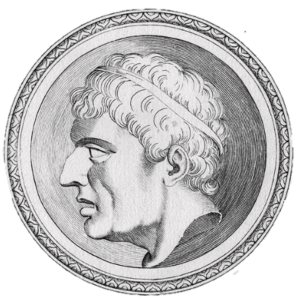
Aratus of Sicyon, as depicted in the Promptuarii Iconum Insigniorum (1533)
|
|
| Native name |
Ἄρατος
|
| Born | 271 BC Sicyon |
| Died | 213 BC Aegium |
| Buried | |
| Allegiance | Achaean League |
| Rank | Strategos |
| Service number | 245-213 BC (with intervals) |
| Battles/wars | Cleomenean War Battle of Sellasia Social War |
| Other work | Advisor of Philip V of Macedon |
Aratus of Sicyon (born 271 BC, died 213 BC) was an important leader and military commander in ancient Greece during the Hellenistic period. He was chosen as strategos (a top military general and leader) of the Achaean League 17 times. He led the League through many wars, including the Cleomenean War and the Social War.
Aratus had a difficult start. When he was only seven years old, his father, a leader in their city of Sicyon, was killed. Aratus had to escape to Argos. In 251 BC, he led a group of exiles back to Sicyon and freed the city from its ruler. Sicyon then joined the Achaean League. Aratus later became its strategos. One of his most famous achievements was capturing the Acrocorinth, a strong fortress in Corinth that people thought could not be taken.
After this victory, Aratus worked to make the Achaean League bigger and stronger. When the Spartan king Cleomenes III took over some Achaean cities, Aratus made an alliance with Macedon, even though they used to be enemies. Together, their forces defeated Cleomenes III at the Battle of Sellasia. Later, during the Social War, Aratus became a trusted advisor to the new king of Macedon, Philip V. Aratus died in 213 BC. Some people believed he was poisoned by Philip, but this is not certain.
Contents
Early Life and Escape
Aratus was born in 271 BC in Sicyon, a city-state in the northern Peloponnese region of Greece. His father, Cleinias, was a main leader of the city. In 264 BC, another man named Abantidas killed Cleinias and took control of Sicyon.
Young Aratus, who was only seven, managed to escape this dangerous situation. His aunt bravely hid him until nightfall and then helped him sneak out of Sicyon to Argos. In Argos, friends of his father raised him. He lived there until 251 BC.
In Argos, Aratus became known as a good athlete, even winning a prize in a competition called the pentathlon. But he never forgot his home city. He was determined to free Sicyon from its rulers. Even though he was young, he gained a lot of support from other exiles and became their leader.
Over time, different rulers took control of Sicyon. Aratus started looking for help from powerful kings in Macedon and Egypt.
Freeing Sicyon
In 251 BC, Aratus planned to attack Sicyon. He learned about a secret way to get into the city by scaling its walls. He armed his men in secret. To trick the ruler's spies, he pretended to have a big feast on the day he planned his attack.
Once the spies left, Aratus and his men went to Sicyon. They climbed the city walls before dawn. They surprised the guards and took them prisoner. The ruler, Nicocles, escaped through a secret tunnel. News of the attack spread quickly, and some citizens set fire to the ruler's house. Aratus allowed the citizens to take back what they had lost after 13 years of harsh rule.
Making Sicyon Stronger
After taking Sicyon, Aratus immediately called back all the people who had been forced to leave. Many of these returning citizens wanted their old property back, which caused arguments. To prevent a civil war, Aratus received a large sum of silver (25 talents) as a gift from a king, possibly Ptolemy II Philadelphos of Egypt. He gave this money to his fellow citizens.
Around 251 BC, Aratus decided to join Sicyon with the Achaean League. This was a big step because Sicyon was the first non-Achaean city to join the League.
However, Sicyon was still struggling financially. Aratus traveled to Egypt to ask Ptolemy II for more help. He returned with a lot of money (40 talents, with a promise of 110 more). Aratus formed a committee to make sure the money was used fairly. Thanks to these funds, Sicyon's problems were solved. The grateful citizens even built a bronze statue to honor Aratus.
Leading the Achaean League
In 245 BC, Aratus was chosen as strategos (general) of the Achaean League. He held this important position almost every two years until he died. His main goal was to make the League bigger and more powerful.
Capturing the Acrocorinth
In his second term as strategos, Aratus set his sights on capturing the Acrocorinth. This was a huge fortress on a hill almost 2,000 feet high, overlooking the city of Corinth. Corinth was a vital city because it controlled the entrance to the Peloponnese and was a major trading center. The Acrocorinth was thought to be impossible to capture.
In 243 BC, Aratus learned about a less steep path to the fortress where the walls were lower. He gathered his army in Sicyon. Aratus took 400 chosen men to the city. They moved quietly, barefoot, to surprise the guards. They managed to kill some guards, but one escaped and raised the alarm.
Aratus and his men reached the citadel (the inner fortress) and tried to climb its walls while defenders threw things down at them. Meanwhile, 300 more soldiers had climbed the outer walls. They attacked and defeated Macedonian soldiers who were arriving. These 300 men then joined Aratus at the citadel.
Aratus's soldiers successfully climbed the citadel walls, and the enemy soldiers gave up. By morning, the Achaeans controlled both the city and the fortress. This was a huge victory for Aratus, showing his clever planning and bravery. He also captured Lechaeum, Corinth's harbor, and 25 Macedonian warships. He left 400 Achaean soldiers and 50 watchdogs to guard the fortress.
Alliance with Sparta
After its capture, Corinth also joined the Achaean League. Soon after, the cities of Megara, Troezen, and Epidaurus joined too. The League became even more famous when Ptolemy III Euergetes, the new king of Egypt, became its honorary leader.
The Achaean League and its rival, Macedon, both looked for new friends. Macedon allied with the Aetolian League. The Achaean League allied with Sparta, one of the strongest city-states in Greece.
In 241 BC, the Aetolian League invaded the Peloponnese. Aratus and the Spartan king, Agis IV, planned to defend the Isthmus of Corinth together. However, they disagreed on how to fight. The Spartan army went home, ending their alliance. This allowed the Aetolians to capture Pellene, an Achaean League member. Aratus quickly gathered his available soldiers and easily defeated the Aetolians.
By 240 BC, Macedon's king, Antigonus, realized the Aetolians were not good allies. He made peace with the Achaeans. This peace did not last long. Antigonus died the next year, and his son Demetrius II became king.
Expanding the League Further
After Antigonus died, the Achaean and Aetolian Leagues surprisingly became allies for about ten years. Aratus continued to focus on making the Achaean League larger by freeing more cities from their rulers. These cities included Argos, Athens, and Megalopolis.
Challenges at Argos
In Argos, the citizens wanted to overthrow their ruler but lacked weapons. Aratus tried to help them by smuggling weapons into the city, but the shipment was caught, and the plan failed. Aratus then led an attack near the city, but the citizens did not join him.
Aratus was determined to free Argos. In 235 BC, he tried again and entered the city at night. But the people of Argos still did not help, leaving the Achaeans to fight alone. Aratus was wounded and had to retreat. This retreat made the ruler, Aristippus of Argos, bolder.
Later, Aratus fought Aristippus's army at the river Xerias. The Achaeans won on one side of the battle, but Aratus was injured on the other side and pulled back. This allowed Aristippus to claim victory. The next day, Aratus decided to retreat because the enemy had more soldiers.
Aratus proposed a truce, which Aristippus accepted. Despite the truce, Aratus captured the city of Cleonae, which Aristippus controlled. There, Aratus held the Nemean Games and sold any Argive people he found into slavery. When Aristippus tried to get Cleonae back, Aratus quickly gathered a new army. He tricked the Argives, then attacked and defeated their army. Aristippus was killed, along with 1,500 of his soldiers. The Achaeans reportedly lost no soldiers. However, this victory did not free Argos. Aristippus's brother, Aristomachus, became the new ruler.
Joining Megalopolis
The city of Megalopolis was founded in 368 BC to be a strong point against Sparta. In 235 BC, its ruler, Lydiades, decided to give up his power and join the Achaean League. This was a very important event. Soon, Orchomenus and Mantinea also joined. Lydiades was even chosen as strategos three times.
Through Aratus's efforts, the Achaean League became a powerful group. It was a strong alliance with an organized army, funded by taxes, and controlled all of the northern Peloponnese.
War Against Demetrius
Demetrius II, the new king of Macedon, saw that the Achaean League was becoming very strong. In 233 BC, he sent an army to the Peloponnese. They defeated the Achaeans near Phylacia. Aratus managed to escape, but rumors spread that he had been killed or captured.
Later, when King Demetrius died in battle, Athens decided to get rid of the Macedonian soldiers in their city. Even though Aratus was sick and not the current strategos, he rushed to help Athens. Aratus convinced the Macedonian commander to give up Piraeus, Munychia, Salamis, and Sunium to Athens for a large sum of money (150 talents), 20 of which Aratus paid himself. For the first time in many years, Athens was free to govern itself. However, Athens chose not to join the Achaean League.
Aristomachus of Argos, Macedon's last ally in the Peloponnese, finally joined the Achaean League. The next year, 228 BC, he was elected strategos. That same year, the alliance between the Achaeans and Aetolians ended. After Demetrius's death, Antigonus III Doson became the regent (ruler for a child king) for Philip V of Macedon. He made a treaty with the Aetolians around 228 BC.
Cleomenean War
Cleomenes Gains Power
In 229 BC, Cleomenes III, the king of Sparta, took three cities from the Aetolian League: Tegea, Orchomenus, and Mantinea. The Achaean League was worried about this because these cities were important.
Sparta then tried to take a fortress called the Athenaeum, which belonged to both Megalopolis and the Achaean League. The Achaean League saw this as a declaration of war. Aratus, who was again strategos, tried to attack Tegea and Orchomenus at night, but his plans were betrayed to Cleomenes.
The Spartans called Cleomenes back to Sparta, perhaps to avoid a full war. But it was too late. While Cleomenes was away, Aratus captured Caphyae. Cleomenes then took another small settlement. In 227 BC, the Achaean army, with 20,000 soldiers, marched out to fight Cleomenes. The Spartans only had 5,000 men, but they were feared. Aratus convinced Aristomachus to pull back, which upset Lydiades, the former ruler of Megalopolis. There were clear tensions within the Achaean League.
The next year, 226 BC, Aratus's army was defeated near Mount Lycaeum. The Achaeans suffered heavy losses. However, Aratus used this defeat to his advantage. He secretly marched to Mantinea and captured that city, opening a route from Argos to Megalopolis. From Mantinea, Aratus went to besiege Orchomenus. But Cleomenes marched to Megalopolis and captured a fortress nearby. Aratus came to help the Megalopolitans and pushed the Spartans back. However, Aratus failed to follow up on his victory. Lydiades, angered, attacked the Spartans with his cavalry, but Aratus did not support him, and Lydiades was defeated and killed. The Spartans then attacked and routed the entire Achaean army.
This defeat brought a lot of criticism for Aratus. The Achaean assembly voted to stop funding him. Aratus thought about resigning but decided to stay on, showing his determination. He then marched to Orchomenus and defeated a Spartan army, capturing Cleomenes's father-in-law, who was quickly ransomed.
In 226 BC, Cleomenes conquered Mantinea, Tegea, and Pharae. He tricked the Achaeans into an open battle in the fall of 226 BC. The reformed Spartan army, now fighting in the "Macedonian way," won a big victory. The Achaeans asked for peace, but Cleomenes refused. Aratus began talking about an alliance between Macedon and the Achaean League. However, Macedon demanded the Acrocorinth back in return for their help. The Achaeans did not want to give up the fortress, so the talks stopped.
In 225 BC, Cleomenes attacked Achaean territory again, trying to take Aratus's home city, Sicyon. He hoped this would cause the Achaean League to fall apart. The plan to take Sicyon failed, but Cleomenes did conquer Pellene, Pheneus, Penteleum, and later Argos. The people of Argos decided to ally with Sparta. Aratus was given special powers to handle the crisis. He went to Corinth, where he faced an angry crowd who had heard he planned to surrender the city to Antigonus. Aratus barely escaped. The Corinthians offered to surrender the city to Cleomenes, even though the Acrocorinth was still held by Achaean soldiers. Cleomenes marched towards Corinth, taking many other cities in Argolis along the way. After surrounding the Acrocorinth, Cleomenes offered a peace treaty to Aratus, who refused. The Spartan king then surrounded Sicyon, destroying the countryside around it.
Macedonian Help Arrives
Just before the siege of Sicyon began, the Achaean leaders decided to accept Macedon's terms for war. Aratus sent his son to Macedon as a hostage. Antigonus was ready with a large army of 20,000 foot soldiers and 3,000 horsemen. When Cleomenes heard about Macedon's involvement, he quickly left the siege of Sicyon. He moved to the Isthmus of Corinth, a better place to meet the northern threat.
Aratus and Antigonus, both practical leaders, got along well despite their initial caution.
Cleomenes's defenses near the Isthmus of Corinth were very strong. It took Antigonus a long time to break through. Later, people from Argos asked Aratus to free their city from the Spartans. Aratus sailed to Epidaurus with 1,500 soldiers to attack Argos. But he found that the city had already been freed by an uprising with the help of Timoxenos, who was then strategos of the Achaean League. Sparta was left almost unprotected. Cleomenes was forced to return to Sparta, leaving his defenses near the Isthmus. This allowed Antigonus to enter the Peloponnese, where he took the Acrocorinth and placed soldiers in the city.
Battle of Sellasia
In 224 BC, while Antigonus was freeing cities in the Peloponnese, Cleomenes was making his army stronger. In the winter of 223 BC, Cleomenes pretended to march to Tegea, but then turned and surprised Megalopolis, capturing the city. About a thousand citizens escaped to Messene. Megalopolis was completely looted. Aratus reportedly cried when he told the Achaean council this news. Antigonus called his troops back from their winter camps, but realized there wasn't enough time to help. Cleomenes, feeling confident, marched on Argos, destroying the countryside.
Antigonus gathered his army, which now had about 27,600 foot soldiers and 1,200 horsemen. Cleomenes took a strong position near Sellasia, before Sparta, to stop the Macedonian king. But Cleomenes was defeated at the Battle of Sellasia in July 222 BC and fled to Egypt. Antigonus conquered Sparta but treated the city kindly and left a few days later.
Social War
In 221 BC, the Aetolians started attacking the land of Messenia. In 220 BC, the Achaean League leaders met to discuss Messene's request for help. Most leaders did not want to attack the Aetolians, but Aratus convinced them. He began to gather an army near Megalopolis, hoping to trap the Aetolians as they returned to their ships. However, the Aetolian commander managed to escape.
The Achaean cavalry had to fight on rough ground, where the Aetolians were much better. Aratus left his good position to help his cavalry. The rest of the Aetolian force took advantage, charging downhill to defeat the Achaeans. After the battle, the Aetolians continued to loot, even raiding Sicyon. They returned home, showing how badly the Achaeans had failed to protect their own land.
Both sides then looked for new allies. The Achaean League again turned to Macedon. The new Macedonian king, Philip V, was not eager for war with the Aetolians. But the Achaeans convinced Philip, and Boeotia, Acarnania, and Epirus also joined the alliance. The Aetolians allied with Sparta and Elis. In 219 BC, they invaded Achaean League territory again. This attack was stopped near Aegeira, but it was not a decisive defeat.
Meanwhile, Philip was preparing his army in Macedon. He won several victories in 218 BC. Philip was helped by Aratus and other advisors. Aratus became very influential and was considered a true friend of the king. Other officers became jealous of Aratus and sometimes insulted him. The king was very angry about this and ordered those responsible to be punished.
After Macedon joined the war, the Aetolians faced more problems. They continued their raids but were often caught in ambushes. Finally, they asked for peace, which was agreed upon in 217 BC.
Death
After the Social War, Philip caused some trouble in Messene. Aratus was unhappy about this and told the king to stop the unrest. Philip was angry but listened to Aratus.
Meanwhile, the First Macedonian War between Macedon and Rome had started. In 214 BC, the Romans defeated Philip near Oricum. That same year, Philip returned to Messene and attacked it for unclear reasons. Aratus had already expressed his disapproval of Philip's actions in Messene, and he did so again, also refusing to support Philip's campaigns.
Aratus's health quickly got worse, and he died in 213 BC. Because there had been tension between the king and Aratus, rumors spread that Philip had poisoned him.
However, modern historians believe this dramatic story is probably not true. Philip had no reason to want Aratus gone. Aratus was still useful, even if he had challenged Philip sometimes. If he had been murdered, there would likely have been a lot of public outcry.
With special permission from the Oracle of Delphi, Aratus was the first person allowed to be buried inside the city walls of Sicyon. He was honored as the 'founder and savior of the city'.
Sources
Ancient sources
Literature
- Roberts, Mike; Bennett, Bob (2012). Twilight of the Hellenistic World. South Yorkshire: Pen & Sword Military. ISBN 9781848841369.
- Walbank, Frank William (1933). Aratos of Sicyon. Cambridge: Cambridge University Press. ISBN 9780598834324.
| Preceded by Margos |
Strategos of the Achaean League 245–244 BC |
Succeeded by Dioedas? |
| Preceded by Dioedas? |
Strategos of the Achaean League 243–242 BC |
Succeeded by Aegialeas |
| Preceded by Aegialeas |
Strategos of the Achaean League 241–240 BC |
Succeeded by ? |
| Preceded by ? |
Strategos of the Achaean League 239–238 BC |
Succeeded by ? |
| Preceded by ? |
Strategos of the Achaean League 237–236 BC |
Succeeded by Dioedas? |
| Preceded by Dioedas? |
Strategos of the Achaean League 235–234 BC |
Succeeded by Lydiades of Megalopolis |
| Preceded by Lydiades of Megalopolis |
Strategos of the Achaean League 233–232 BC |
Succeeded by Lydiades of Megalopolis |
| Preceded by Lydiades of Megalopolis |
Strategos of the Achaean League 231–230 BC |
Succeeded by Lydiades of Megalopolis |
| Preceded by Lydiades of Megalopolis |
Strategos of the Achaean League 229–228 BC |
Succeeded by Aristomachus of Argos |
| Preceded by Aristomachus of Argos |
Strategos of the Achaean League 227–226 BC |
Succeeded by Hyperuatas |
| Vacant
ad hoc position
|
Strategos autokrator of the Achaean League 225–222 BC |
Vacant
ad hoc position
|
| Preceded by Timoxenos |
Strategos of the Achaean League 224–223 BC |
Succeeded by Timoxenos? |
| Preceded by Timoxenos? |
Strategos of the Achaean League 222–221 BC |
Succeeded by Timoxenos |
| Preceded by Timoxenos |
Strategos of the Achaean League 220–219 BC |
Succeeded by Aratus the Younger |
| Preceded by Epiratos |
Strategos of the Achaean League 217–216 BC |
Succeeded by Timoxenos |
| Preceded by Timoxenos |
Strategos of the Achaean League 215–214 BC |
Succeeded by ? |
| Preceded by ? |
Strategos of the Achaean League 213 BC |
Succeeded by Cycliadas? |
Images for kids
-
Antigonus Gonatas, king of Macedon
-
The hill on which the Acrocorinth stood
-
Opposing armies in the Battle of Sellasia
See also
 In Spanish: Arato de Sición para niños
In Spanish: Arato de Sición para niños


